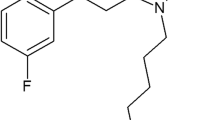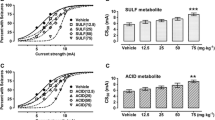Abstract
Excitatory amino acids participate in the generation of seizure activity. Consequently, the effects of GYKI 52466 [1-(4-aminophenyl)-4-methoxy-7,8-methylenedioxy-5H-2,3-benzodiazepine hydrochloride], an antagonist of glutamate-mediated events, on the protective activity of conventional antiepileptic drugs against pentetrazol were studied.
GYKI 52466 (up to 10 mg/kg, ip) did not affect the clonic phase of pentetrazol (injected sc at its CD97 of 90 mg/kg) convulsions. Only the antipentetrazol activity of valproate (100 mg/kg) was enhanced by GYKI 52466 (10 mg/kg)—the percentage of mice protected was significantly increased from 20 to 90%. The anticonvulsive activity of clonazepam (at 0.01), ethosuximide (at 50), and phenobarbital (at 2.5 mg/Kg) was not modified by GYKI 52466 (up to 10 mg/kg). The combination of valproate (100 mg/kg) with GYKI 52466 (10 mg/kg) did not affect the performance of mice evaluated in the chimmey test. However, this combination resulted in significant memory deficits, measured in the passive avoidance task. In no case did GYKI 52466 (10 mg/kg) affect either total or free plasma levels of antiepileptic drugs (as measured by immunofluorescence), so a pharmacokinetic interaction is not probable. Finally, the interaction of the non-NMDA receptor antagonist with antiepileptic drugs does not seem promising in the pentetrazol test, recognized as a model of human myoclonic epilepsy.
Similar content being viewed by others
References
Boissier J. R., Tardy J., and Diverres J. C. (1960) Une nouvelle methode simple pour explorer l’action ‘tranquilisante’: le test de la cheminee.Med. Exp. 3, 81–84.
Borowicz K. K., Gasior M., Kleinrok Z., and Czuczwar S. J. (1995) The non-competitive AMPA/kainate receptor antagonist, GYKI 52466, potentiates the anticonvulsant activity of conventional antiepileptics.Eur. J. Pharmacol. 281, 319–326.
Borowicz K. K., Gasior M., Kleinrok Z., and Czuczwar S. J. (1996) Competitive NMDA-receptor antagonists, LY 235959 and LY 233053, enhance the protective efficacy of various antiepileptic drugs against maximal electroshock-induced seizures in mice.Epilepsia 37, 618–624.
Chapman A. G., Smith S. E., and Meldrum B. S. (1991) The anticonvulsant effect of the non-NMDA antagonists, NBQX and GYKI 52466, in mice.Epilepsy Res. 9, 92–96.
Coulter D. A., Huguenard J. R., and Prince D. A. (1989) Specific petit mal anticonvulsants reduce calcium currents in thalamic neurons.Neurosci. Lett. 98, 74–78.
Croucher M. J., Collins J. F., and Meldrum B. S. (1982) Anticonvulsant action of excitatory amino acid antagonists.Science 216, 899–901.
Crowder J. M. and Bradford H. F. (1987) Common anticonvulsants inhibit Ca2+ uptake and amino acid neurotransmitter release in vitro.Epilepsia 28, 378–382.
Czechowska G., Dziki M., Pietrasiewicz M., Kleinrok Z., Turski W. A., and Czuczwar S. J. (1993) Competitive antagonists of NMDA receptors, CGP 37849 and CGP 39551, enhance the anticonvulsant activity of valproate against electroconvulsions in mice.Eur. J. Pharmacol. 232, 59–64.
Czuczwar S. J. and Meldrum B. (1982) Protection against chemically induced seizures by 2-amino-7-phosphonoheptanoic acid.Eur. J. Pharmacol. 83, 335–338.
Czuczwar S. J., Turski L., Schwarz M., Turski W. A., and Kleinrok Z. (1984) Effects of excitatory amino-acid antagonists on the anticonvulsant action of phenobarbital or diphenylhydantoin in mice.Eur. J. Pharmacol. 100, 357–362.
Czuczwar S. J., Cavalheiro E. A., Turski L., Turski W. A., and Kleinrok Z. (1985a) Phosphonic analogues of excitatory amino acids raise the threshold for maximal electroconvulsions in mice.Neurosci. Res. 3, 86–90.
Czuczwar S. J., Frey H.-H., and Löscher W. (1985b)N-methyl-D,L-aspartic acid-induced convulsions in mice and their blockade by antiepileptic drugs and other agents, inNeurotransmitters, Seizures, and Epilepsy III (Nisticò G., Morselli P. L., Lloyd K. G., Fariello R. G., and Engel J., jr., eds.), pp. 235–246, Raven, New York.
Czuczwar S. J., Borowicz K. K., Kleinrok Z., Tutka P., Zarnowski T., and Turski W. A. (1995) Influence of combined treatment with NMDA and non-NMDA receptor antagonists on electroconvulsions in mice.Eur. J. Pharmacol. 281, 327–333.
Gasior M., Kamiński R., Brudniak T., Kleinrok Z., and Czuczwar S. J. (1986) Influence of nicardipine, nimodipine and flunarizine on the anticonvulsant efficacy of antiepileptics against pentylenetetrazol in mice.J. Neural. Transm. 103, 819–831.
Haefely W. E. (1980) GABA and the anticonvulsant action of benzodiazepines and barbiturates.Brain Res. Bull. 5(Suppl. 2), S140-S149.
Hayashi T. (1954) Effects of sodium glutamate on the nervous system.Keio J. Med. 3, 183–192.
Litchfield J. T. and Wilcoxon F. (1949) A simplified method of evaluating dose-effect experiments.J. Pharmacol. Exp. Ther. 96, 99–113.
Löscher W. and Hönack D. (1991) Anticonvulsant and behavioral effects of two novel competitiveN-methyl-D-aspartic acid receptor antagonists, CGP 37849 and CGP 39551, in the kindling model of epilepsy. Comparison with MK-801 and carbamazepine.J. Pharmacol. Exp. Ther. 256, 432–440.
Löscher W. and Hönack D. (1994) Effects of the non-NMDA antagonists NBQX and the 2,3-benzodiazepine GYKI 52466 on different seizure types in mice: comparison with diazepam and interactions with flumazenil.Br. J. Pharmacol. 113, 1349–1357.
Löscher W. and Schmidt D. (1988) Which animal models should be used in the search for new antiepileptic drugs? A proposal based on experimental and clinical considerations.Epilepsy Res. 2, 145–181.
Löscher W., Rundfeldt C., and Hönack D. (1993) Low doses of NMDA receptor antagonists synergistically increase the anticonvulsant effect of the AMPA receptor antagonist NBQX in the kindling model of epilepsy.Eur. J. Neurosci. 5, 1545–1550.
Meldrum B. (1992) Excitatory amino acids in epilepsy and potential novel therapies.Epilepsy Res. 12, 189–197.
Parada J., Czuczwar S. J., and Turski W. A. (1992) NBQX does not affect learning and memory tasks in mice: a comparison withd-CPP-ene and ifenprodil.Cog. Brain Res. 1, 67–71.
Parada-Turska J. and Turski W. A. (1990) Excitatory amino acid antagonists and memory: effects of drugs acting at N-methyl-d-aspartate receptors in learning and memory.Neuropharmacology 29, 1111–1116.
Pietrasiewicz T., Czechowska G., Dziki M., Turski W. A., Kleinrok Z., and Czuczwar S. J. (1993) Competitive NMDA receptor antagonists enhance the antielectroshock activity of various antiepileptics.Eur. J. Pharmacol. 250, 1–7.
Smith S. E., Dürmüller N., and Meldrum B. (1991) The non-N-methyl-d-aspartate receptor antagonists, GYKI 52466 and NBQX, are anticonvulsant in two animal models of reflex epilepsy.Eur. J. Pharmacol. 201, 179–183.
Tarnawa T., Engberg I., and Flatman J. A. (1990) GYKI 52466, an inhibitor of spinal reflexes is a potent quisqualate antagonist, inAmino Acids: Chemistry, Biology and Medicine (Lubec G. and Rosenthal G. A., eds.), pp. 538–546, Escom, Leiden.
Turski L., Jacobsen P., Honoré T., and Stephens D. N. (1992) Relief of experimental spasticity and anxiolytic/anticonvulsant actions of the α-amino-3-hydroxy-5-methyl-4-isoxazole-propionate antagonist 2,3-dihydroxy-6-nitro-7-sulfamoylbenzo(F)quinoxaline.J. Pharmacol. Exp. Ther. 260, 742–747.
Urbańska E., Dziki M., Kleinrok Z., Czuczwar S. J., and Turski W. A. (1991) Influence of MK-801 on the anticonvulsant activity of antiepileptics.Eur. J. Pharmacol. 200, 277–282.
Urbańska E., Dziki M., Czuczwar S. J., Kleinrok Z., and Turski W. A. (1992) Antiparkinsonian drugs memantine and trihexyphenidyl potentiate the anticonvulsant activity of valproate against maximal electroshock-induced seizures.Neuropharmacology 31, 1021–1026.
Venault P., Chapouthier G., de Carvallo L. P., Simiand J., Morre M., Dodd R. H., et al. (1986) Benzodiazepines impair and beta-carbolines enhance performance in learning and memory tasks.Nature 321, 864–866.
Watkins J. C., Krogsgaard-Larsen P., and Honoré T. (1990) Structure-activity relationships in the development of excitatory amino acid receptor agonists and competitive antagonists.Trends Pharmacol. Sci. 11, 25–33.
Yamaguchi S., Donevan S. D., and Rogawski M. A. (1993) Anticonvulsant activity of AMPA/kainate antagonists: comparison of GYKI 52466 and NBQX in maximal electroshock and chemoconvulsant seizure models.Epilepsy Res. 15, 179–184.
Żarnowski T., Kleinrok Z., Turski W.A., and Czuczwar S.J. (1993) 2,3-Dihydroxy-6-nitro-7-sulfamoylbenzo(F)quinoxaline enhances the protective activity of common antiepileptic drugs against maximal electroshock-induced seizures in mice.Neuropharmacology,32, 895–900.
Żarnowski T., Kleinrok Z., Turski W. A., and Czuczwar S. J. (1994a) The NMDA antagonist procyclidine, but not ifenprodil, enhances the protective efficacy of common antiepileptics against maximal electroshock-induced seizures in mice.J. Neural Transm. 97, 1–12.
Żarnowski T., Kleinrok Z., Turski W. A., and Czuczwar S. J. (1994b) The competitive NMDA antagonist,d-CPP-ene, potentiates the anticonvulsant activity of conventional antiepileptics against maximal electroshock-induced seizures in mice.Neuropharmacology 33, 619–624.
Zeise M. L., Kasparow S., and Zieglgansberger W. (1991) Valproate suppresses N-methyl-d-aspartate-evoked transient depolarization in the rat neocortex in vitro.Brain Res. 544, 345–348.
Zorumski C. F. and Thio L. L. (1992) Properties of vertebrate glutamate receptors: calcium mobilization and desensitization.Prog. Neurobiol. 39, 295–336.
Author information
Authors and Affiliations
Corresponding author
Rights and permissions
About this article
Cite this article
Czuczwar, S.J., Gąsior, M., Kamiński, R. et al. GYKI 52466 [1-(4-aminophenyl)-4-methoxy-7,8-methylenedioxy-5H-2,3-benzodiazepine hydrochloride] and the anticonvulsive activity of conventional antiepileptics against pentetrazol in mice. Molecular and Chemical Neuropathology 33, 149–162 (1998). https://doi.org/10.1007/BF02815178
Received:
Revised:
Accepted:
Issue Date:
DOI: https://doi.org/10.1007/BF02815178




